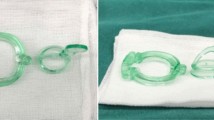Abstract
Purpose
To compare the results of a new disposable clamp (SCD) used for routine circumcision in our department, compared with the conventional dissection tecnique (CDT) in infants and children.
Methods
The SCD and CDT were evaluated prospectively, in terms of the duration, complication rate and postoperative pain assesment. The cosmetic result and parents' satisfaction were evaluated after 6 weeks. A total of 200 boys were included in the study (with a median age of 4.45 years).
Results and conclusions
The median operative duration was 10 min less for the SCD (18 vs 8 min; P < 0.001). There was no difference in complication rates for both groups. The cosmetic results assessed by a blinded urologist were better for the SCD group (P < 0.001). The parents' satisfaction score for the procedure was similar in both groups, as 8 out of a scale up to 10 filled in by the parents. Circumcision with the SCD is quicker and leads to a better cosmetic results than with the CDT, without increasing morbidity.



Similar content being viewed by others
Abbreviations
- SCD:
-
Smart Clamp Device
- CDT:
-
Conventional dissection technique
- IQR:
-
Interquartile range
References
Waszak SJ (1978) The historic significance of circumcision. Obstet Gynecol 51:499–501
Andrasik F, Burke EJ, Attanasio V, Rosenblum EL (1985) Child parent, and physician reports of a child’s headache pain: relationships prior and following treatment. Headache 25:421–425
Linssen AC, Spinhoven P (1991) Pain measurment in clinical practice. Ned Tijdschr Geneeskd 135:557–560
Singer AJ, Thode HC Jr (1998) Determination of the minimal clinically significant difference on a patient visual analog satisfaction scale. Acad Emerg Med 10:1007–1011
Grossman E, Posner NA (1981) Surgical circumcision of neonates: a history of its development. Obstet Gynecol 58:241–246
Holman JR, Lewis EL, Ringler RL (1995) Neonatal circumcision techniques. Am Fam Physician 52:511–520
Fraser IA, Allen MJ, Bagshaw PF, Johnstone M (1981) A randomised trial to assess childhood circumcision with the Plastibell device compared to a conventional dissection technique. Br J Surg 68:593–595
Özdemir E (1995) A review of circumcision from Turkey. Hamdard Med 38:69–86
Leitch IO (1970) Circumcision a continuing enigma. Aust Pediatr J 6:59–65
MacCarthy D, Douglas JW, Mogford C (1952) Circumcision in a national sample of 4 year old children. Br Med J 2:755–756
Author information
Authors and Affiliations
Corresponding author
Rights and permissions
About this article
Cite this article
Aldemir, M., Çakan, M. & Burgu, B. Circumcision with a new disposable clamp: Is it really easier and more reliable?. Int Urol Nephrol 40, 377–381 (2008). https://doi.org/10.1007/s11255-007-9275-x
Received:
Accepted:
Published:
Issue Date:
DOI: https://doi.org/10.1007/s11255-007-9275-x



